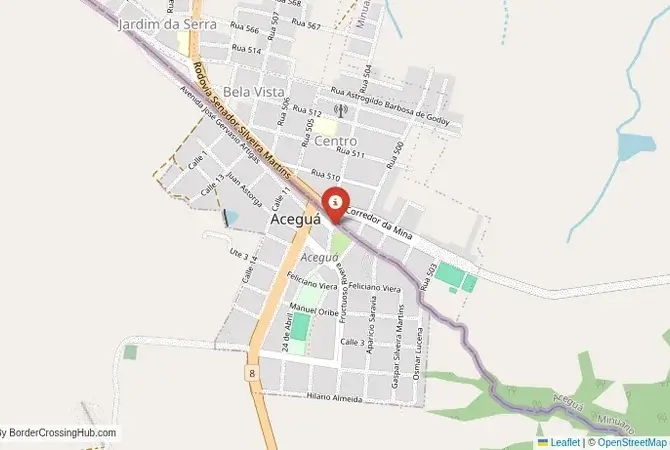
Approximate Border Location
Wait Times
30-60 min for pedestrians/vehicles
Operating Hours
Open 8:00 AM – 6:00 PM
Crossing Types
Pedestrians, vehicles
Border Type
Land crossing via road
Peak Times
Mornings (7-10 AM)
Daily Crossings
~1000 travelers/vehicles
Currency Exchange
Limited near Aceguá (BRL, UYU)
Safety Information
Remote, beware wildlife
Languages Spoken
Portuguese, Spanish
Accessibility Features
Ramps
About Aceguá & Aceguá
A Crossing in the Heart of the Pampas
The border crossing connecting the Brazilian village of Aceguá with its twin village of Aceguá in Uruguay is a journey into the deep, rural heart of the Gaúcho pampas. This is not a bustling commercial corridor or a major tourist route; it is a quiet, local checkpoint on an open, urban border where a single main street is the only thing separating two nations. To cross here is to experience the “Fronteira da Paz” (Frontier of Peace) at its most authentic and tranquil. It is a seamless passage through a landscape of vast, rolling grasslands, a place defined by the traditions of cattle ranching and the shared Gaúcho culture that has always ignored the political line on the map.
Operational Details
This checkpoint connects Brazil’s Rio Grande do Sul state with the Cerro Largo Department of Uruguay. There is no single, mandatory checkpoint for moving between the two villages. People cross freely for daily life. However, formal, integrated immigration and customs offices (a joint facility) are located on the main road for travelers who need to officially enter or exit the country—a crucial step for anyone not just visiting for the day. The crossing is open 24/7, but the traffic is very light, consisting almost entirely of local residents and those involved in the agricultural economy.
Before Crossing
Crossing borders gets messy sometimes, think political flare-ups or gates shutting fast. Good travel insurance is a must for handling doctor visits, trip disruptions, or security scares. Don’t get caught unprepared. To find a policy that’s got your back, check out reliable plans today for peace of mind.
A History of a Gaúcho Heartland
The history of this region is the history of the Pampa, the vast grasslands that are the heartland of the Gaúcho (Gaucho in Spanish) culture. This has been a land of cattle ranching and a contested frontier between the Spanish and Portuguese empires for centuries. The modern border was established in the 19th century, but the shared Gaúcho culture, with its traditions of horsemanship, barbecue (churrasco/asado), and mate (chimarrão/mate), has always transcended the political line. The two villages of Aceguá grew up together as small service centers for the surrounding large ranches (`estâncias`/`estancias`). The open border is a reflection of the deep, practical, and historical integration of the community.
The Unique Border Procedure
The border crossing procedure is unique. For local movement, there are no checks. However, for foreign tourists or for anyone planning to travel further into either country, it is absolutely essential to stop at the integrated border post and get the proper entry and exit stamps. Failure to do so can result in significant fines and legal problems when you try to leave the country from another point. The open nature of the urban border can be deceptive; the formal requirements are still very much in place for international travelers. The joint border post is a model of efficient, modern border management.
The Surrounding Region: Brazil Side
On the Brazilian side, Aceguá is a small, quiet town that serves as a commercial center for the surrounding agricultural region. It is located near the major city of Bagé, the “Queen of the Frontier,” which is a major center of the “Campanha Gaúcha.” The region is known for its high-quality beef production, its fine-wool sheep, and its growing wine industry. The landscape is one of vast, open grasslands, dotted with large ranches and historic farmhouses. It is a paradise for those who love wide-open spaces.
The Surrounding Region: Uruguay Side
On the Uruguayan side, Aceguá is also a small, quiet town. Like other Uruguayan border towns, it has a number of duty-free shops (“free shops”) which are an attraction for Brazilian shoppers, though on a much smaller scale than in cities like Rivera or Chuy. The crossing is a gateway to the Cerro Largo department, a region of rolling hills and cattle ranches. The nearby city of Melo is the main regional center, famous as the setting for the film “The Pope’s Toilet” (El Baño del Papa).
Practical Travel Information
Practical planning is essential. Remember to get your passport stamped if you are traveling further into either country. The official currencies are the Brazilian Real (BRL) in Brazil and the Uruguayan Peso (UYU) in Uruguay. Services are limited in the small towns, so it is best to plan for fuel and major needs in the larger cities of Bagé or Melo. Vehicle insurance (Carta Verde) is mandatory for driving between the two countries. This is a very quiet and safe crossing, offering a relaxed alternative to the busier border posts.
Final Considerations
The Aceguá–Aceguá border crossing is a journey into the heart of the pampas. It is a symbol of the deep cultural integration between Brazil and Uruguay at its most local and authentic level. It is a quiet, peaceful hub of a shared Gaúcho culture. For the traveler, it offers a unique cultural experience, a glimpse into a world where two nations meet and merge on a single street in the middle of the vast, beautiful grasslands of South America.
No reviews yet.
